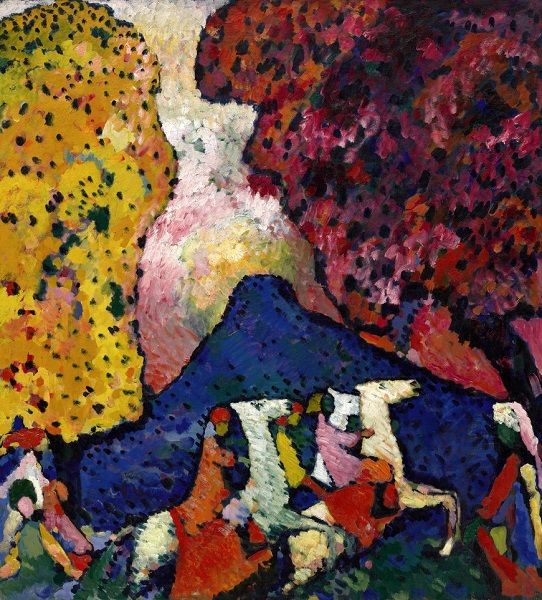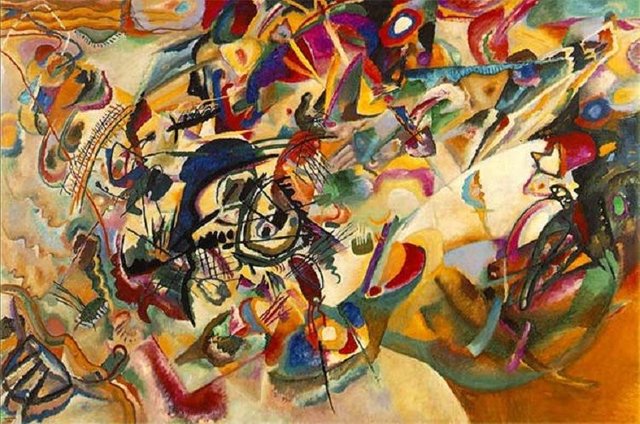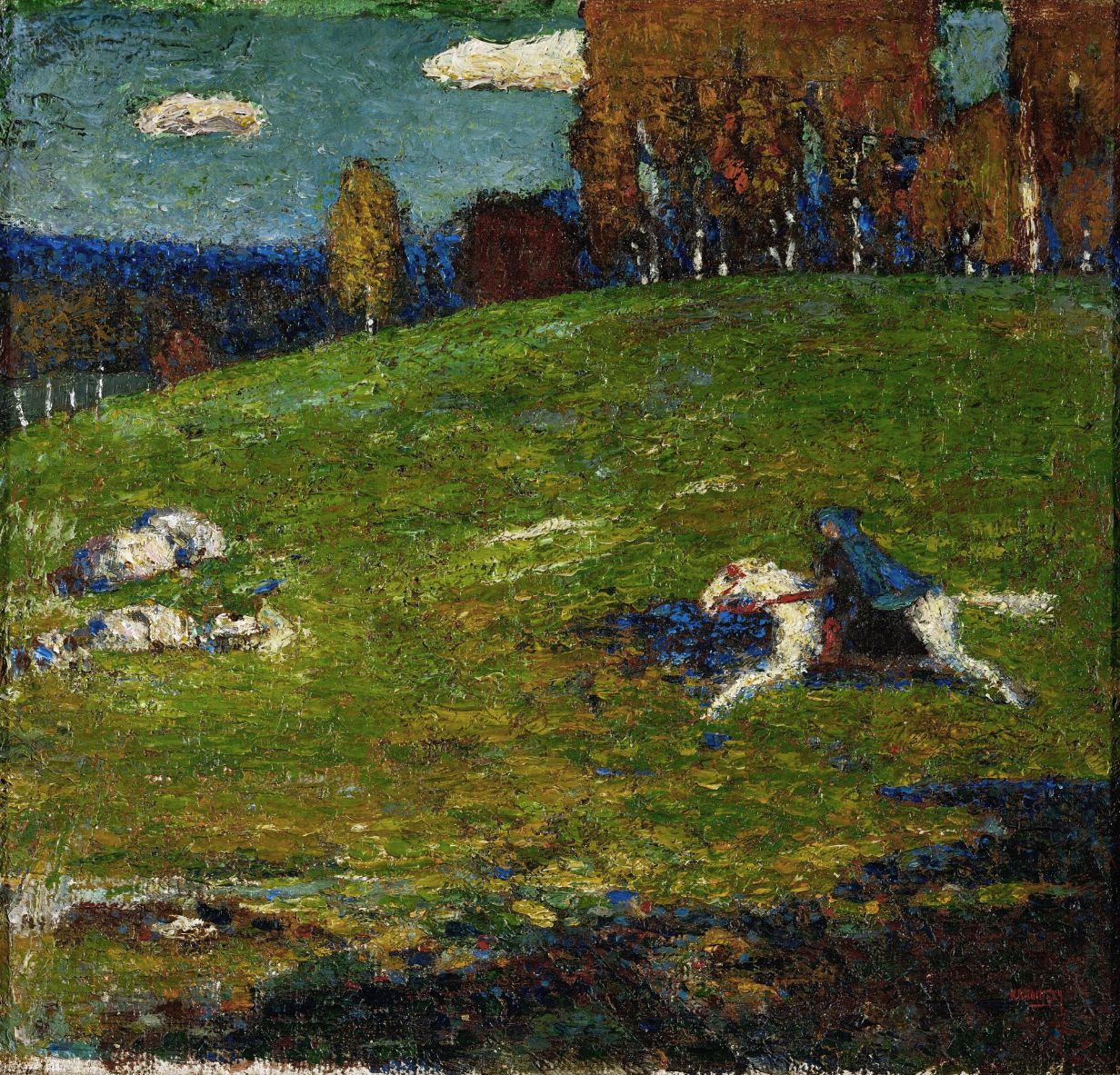Kandinsky and his meaning in art
Wassily Kandinsky is a world-famous expressionist and is proclaimed father of abstractionism. He was born today, December 16, 1866, in Moscow. He is the man we associate with the theory of color association. Kandinsky has a keen sense of color and shapes. He attributes meaningful associations to them and arranges them in opposite pairs. Do you know that blue (cold, sky, metaphysics, infinity, calmness, concentricity) stands against yellow (warmth, earth, aggression, eccentricity), black (darkness, hopelessness) against white (light, possibility); red (life, excitement, strength) against green (calmness, immobility), and orange (irritation, movement) against violet (chilled red) ...

1909, Blue Mountain
Did you also know that the blue color with is circle, the red is a square, and the yellow is a triangle. This bondage of colors with theoretical forms of art and thinking is also the work of the famous artist and thinker of the 19th century. Kandinsky is a Russian painter and art theorist, whose development and work have gone mainly to Germany and France. He initially created watercolors. Basil originates and lives first in Munich and then in Russia, but due to the conditions of Russian communism - the censorship of the totalitarian regime - he is forced to emigrate. He first took a teaching assignment in Bauhaus in Germany and escaped to Paris after the closure of the National Socialist School. Wassily Kandinsky was born in a wealthy family of Moscow who trades with tea, but while his parents are too young, they divide. He grew up almost without a father and was raised mainly by his aunt Elisabeth. He attends Lomonosov University to study law, economics and ethnology. But it seems like his passion is moving in another direction. This is the period in which he begins to paint and attend exhibitions. He did not accept working at the University of Tartu, Estonia in 1896, and instead moved to Munich, where between 1897 and 1899 he attended the private art school of Anton Ajbe, and from 1890 at the Art Academy in Munich with Franz von Stuk.

Kandinsky Composition VII
1901 Kandinsky is among the founders of the Falanga artistic group and the painting school attached to it. During his lecture, he meet with Gabriel Münter, who became a life partner, although the artist was already married in Russia. 1902 for the first time exhibited in the Berlin Secession. Since 1904, he has been presented at the Autumn Salon in Paris. The Paris period influenced Kandinsky exclusively. After returning to Munich in 1908, they both went to South Tyrol for the same spring, where they continued to paint in the style of late Impressionism. Murnau am Staplesee was an important step in Kandinsky's artistic development. There was a collaboration with Maranne Verefkin and Alexey von Yavlenski, which influenced his style and technique of painting. Münter and Kandinsky make a great step forward in their creativity, inspired not only to recreate nature, but instead to abstain from the visible and to give it extracts. For a short while, Kandinsky and Münter become expressive artists. During this period, Kandinsky met Rudolf Steiner, whose theosophy and then anthroposophy influenced his further work. In January 1911, Kandinsky relinquished his presidency in "Neue Künstlervereinigung Müncheafter" being criticized for his increasingly abstract works and pressed to paint "more comprehensible." Like any great artist, he remains misunderstood in his time. On December 18, 1911, the first exhibition of the Blue Rider was opened at the Tanchauser Gallery in Munich. In parallel with this exhibition, Kandinsky's book "Concerning the Spiritual in Art" was published and presented. Half a year later, in May 1912, the Almanac "The Blue Rider" was published. It is the thoughts gathered in this book that are considered the basis of abstract art and its further development.
%2C_oil_on_canvas%2C_52.1_x_54.6_cm%2C_Stiftung_Sammlung_E.G._B%C3%BChrle%2C_Zurich.jpg)
Der Blaue Reiter, 1903, V. Kandinsky
In 1914, due to the inability to stay in Germany, he fled with Gabriele Münter in Switzerland. From there he returned to Russia and settled in Moscow. Kandinsky received various professions and founded his own "Academy of Arts Sciences". Following are prestigious positions in the home country - a member of the Fine Arts Department at Narcompros' USSR Education Office, a functionary in 1920 as the head of the Institute of Art Culture. Kandinsky's irrational and emotional nature runs counter to the rationalism of other Russian avant-gardists, and this has become particularly noticeable since the revolution. The October Revolution made him a poor man because he lost his uncle's inheritance. Kandinsky does not understand and disagree with the new order and the situation in the Soviet Union, and basically the violation of freedom of the art. This is the reason to leave his country and join the Weimar School Bauhaus. He managed to leave the Soviet Union legally, but he took only 12 paintings with him. The rest of his work remains in the Moscow Museum. Then followed Paris, where he died in 1944. An artist and thinker traveled the trajectories of the European cities where the art evolved and experienced the turning of time. There is something else in which Kandinsky is the first in art, because like any genius he is more a thinker and a philosopher than an artist. In his work, biomorphic, non-geometric shapes with soft contours appear. Forms reminiscent of microorganisms, but always depicting the artist's inner life. Known for using unusual color compositions that mimic Slavonic folk art. He experiments a lot and one of the things he introduces to admix sand in his paint to give a roughness to the colors. 7 years younger Nina Kandinsky survived her husband for 36 years. It is the task of managing his inheritance. Thanks to her, the rest of the paintings find themselves in the big, world-famous museums. One such action is the donation of 30 paintings and watercolors to the Paris Center "Georges Pompidou". She also founded the Kandinsky Art Prize in 1946.
In conlusion Kandinsky is the focus of all the ways in the development of modern painting. A great esthete of the new plastic art, he embraces in his art the fetters of all new trends: in a dazzling logical way, he has passed all degrees in the consistent development of the basic principle of every art: simplicity. Beginning with the colorful effects of neo-impressionism (he is passionately in love with color), Kandinsky begins on the path of aesthetic excommunication from the substance, from the form that he possesses in Impressionism, and reaches the astonishing minimum of paint and line (the primary elements of painting), - which give him an absolute expressionist artistic expression. This is the last step of painting: painting freed from the bonds of the outer, the near meaningful form, free from the necessity of realistic allegory.
If you like abstract art you can read:
A brief introduction into the abstract art
Hilma af Klint - the mother of the abstract art
Looking nice sletch
Thank you :)
Kandinsky is definitely one of the best when it comes to symbolism, so simple yet deeply meaningful. He was also my professor's favorite!
And one of my lecturers was his favorite, and when I did a course work for Kandinsky he could not hide his joy :D
I love Kadinsky! He is a strong inspiration for my art.
You have really interesting works. I follow you to see more of you :)
Thank you!! I am following you too!
good art story culture writing creative post thank for shearing
thanks
muy buenas pinturas e historia gracias por compartirlo
You are welcome :)
Informative blog !
Your way of expression through abstract is really amazing .
Specially colour combination is very attractive
I am glad it is useful for you :)
You have received an upvote from @nicestbot. I am an automated curation bot trying to make minnows happy.
Thanks.
nice information about Kandinsky and his arts
Kadinsky is one of my favourite Bauhaus artists and this article does a great job of giving a brief history of his life and work. One small question, why do you write that he was born today, Decemeber 16? Seems a little out of place.
There are many hard art@godflesh.
true